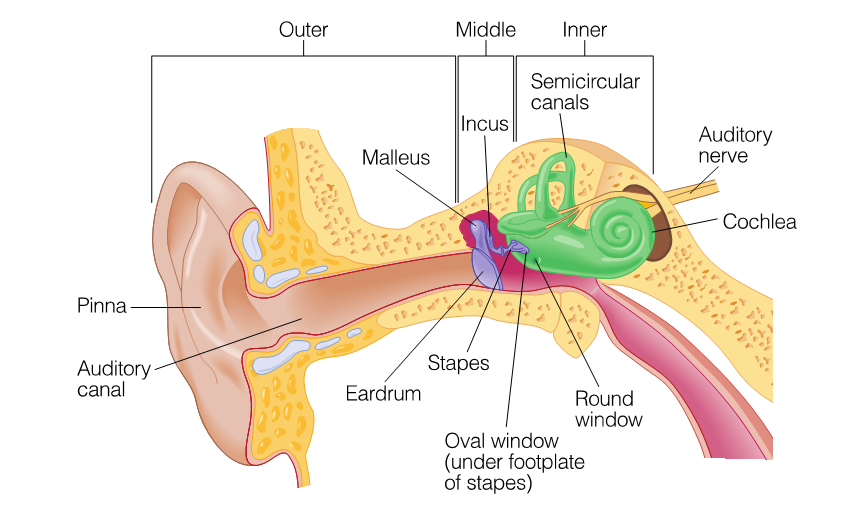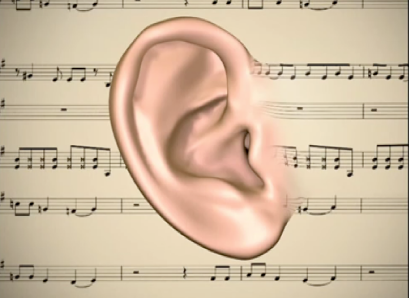P4: Loudness & Pitch
1/16
There's no tags or description
Looks like no tags are added yet.
Name | Mastery | Learn | Test | Matching | Spaced |
|---|
No study sessions yet.
17 Terms
The sound stimulus
“If a tree falls and there is no one to hear it, would there be a sound?”
What is sound? def.
Perceptual definition = sound is the experience we have when we hear
Physical definition = sound is pressure changes in the air or other medium caused by the vibration of an object
A pure tone occurs when changes in air pressure form a perfect sinusoidal wave
Characteristics of sound - pure tones
Amplitude
Size of the variation in air pressure (I.e difference between peak and trough
Related to perception of loudness
Frequency
Number of cycles per second (1 hertz = 1 cycle/s)
Related to perception of pitch
Characteristics of sound - complex sounds
Most sounds encountered in the world are more complex than pure tones
All sound waves can be described as some combination of sine waves
Natural sounds often consist of a fundamental frequency superimposed by additional waveforms with higher frequencies (the harmonics)
Overview of the ear
The human ear is divided into 3 sub-divisions: outer, middle and inner

Outer ear
Pinnae = visible external parts of the ear
Auditory canal = 3cm tube-like structure, protects middle ear
Tympanic membrane (eardrum) = Cone-shaped, separating the outer and middle ear
Sound waves induce a difference in pressure either side of tympanic membrane causing it to vibrate
Larger amplitude sounds = larger vibrations
Higher frequency sounds = faster vibrations

Middle ear
The middle ear = small cavity (approv. 2 cubic cm) that contains the ossicles
Malleus (hammer)
Incus (anvil)
Stapes (stirrup)
The bones amplify the vibrations of the tympanic membrane and transmit them to the inner ear at the oval window
Inner ear
The main structure of the inner ear is the cochlea, a snail-like liquid filled organ
Vibration of the oval window displaces fluid in the cochlea, resulting in a change in pressure which propagates up and down the spiral structure
Cochlea consists of 3 parallel canals: vestibular, middle and tympanic
Auditory transduction is triggered by motion of the basilar membrane, which separates the middle and tympanic canals
Auditory transduction
Motion of the basilar membrane are translated into neural signals by structures in Organ of Corti, which extends along its surface
A voltage is generated when specialised hair cells contained within the organ of corti are bent
This produces impulses in auditory nerve cells which are sent to the brain
Hair cells are extremely sensitive
Overstimulation by loud sounds can damage hair cells and lead to hearing loss
Loudness
Our perception of loudness is related to the amplitude of sound waves
The range of amplitude we encounter is extremely large
Eg. The amplitude of a very loud sound at a rock concert might be up to 1,000,000 times that of a sound you could barely hear
Loudness (2)
In order to describe differences in amplitude, sound levels are measured on a logarithmic scale in units called decibels (dB)
A change of 20dB corresponds to a ten-fold increase in amplitude
Loudness (3)
Rate code: Sound amplitude is coded in the firing rate of auditory nerve fibers
Responses increase with increasing sound intensity
Note, some fibers have high spontaneous rates and saturate rapidly, while others have low spontaneous rates and saturate slowly
This enables us to discriminate loudness across a range of sound levels
Loudness (4)
Loudness depends on amplitude (but the two are not directly proportional)
For a sound to be perceived as twice as loud, its amplitude needs to be increased by a factor of approx. 3.16 (10dB)
Loudness (5)
Loudness depends on the frequency:
Our auditory systems are not equally sensitive to all sound frequencies
The red curves here indicate the number of decibels required to create the same perception of loudness at different frequencies
Pitch
Humans are sensitive to a wide range of sound frequencies
The lowest frequency humans can hear is 20Hz (below that we can't hear the sound, but are able to feel it)
The highest frequency humans can hear is 20,000Hz (20kHz)
Pitch - Place code
Sound frequencies cause vibrations in specific areas along the basilar membrane
Low frequencies – near apex
High frequencies – near base
Pitch - Timing code
Frequency is not only signalled by which auditory nerve, but also WHEN they respond
Auditory nerve responses are synchronised to changes in pressure
This property is called phase-locking and occurs up to frequencies of about 4,000Hz